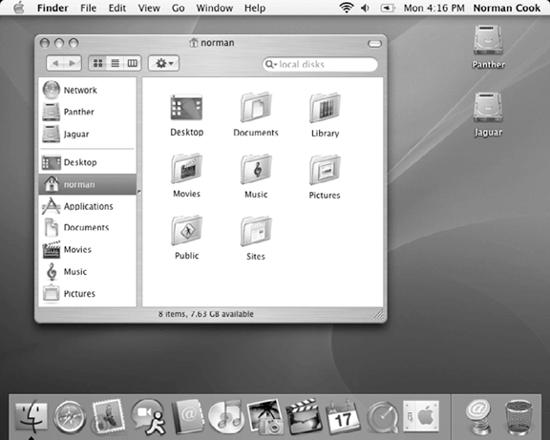Panther, the name given to Mac OS X 10.3, brought another host of improvements to the system and continued in the Mac OS X tradition of “It’s getting better all the time.” A few of the improvements made to the system were:
- A new Finder
The Finder that shipped with Mac OS X 10.0 through 10.2 was a simplified interpretation of the classic Finder from the original Mac OS that was designed to work on a single-user system. On the multiuser Mac OS X, this meant the files that typical users cared about—those in their Home directories—were located three levels away from the filesystem root.
The Finder in Panther, shown in Figure 1-7, introduced a new Sidebar on the left side of every Finder window that gives you quick access to the various disks attached to your computer, your Home directory, and any other locations that you put there. When you select a disk or a folder from the Sidebar, it becomes the start of what you see in the window view. And, changing a paradigm in place since 1984, Panther’s Finder made it so that removable disks can be ejected or disconnected by clicking on an eject icon in the Sidebar, rather than having to drag disks to the Trash.
- Exposé
Building on the power of Quartz Extreme, Exposé introduced a new way to work with the dozens of windows that are open on the typical Mac OS X user’s desktop. Instead of having to dig through the open windows one by one, you can use either a keystroke or a mouse gesture and perform one of three actions:
Show all the windows open in miniature so you can see all of them at once.
Show all the windows belonging to a particular application.
Clear all the windows off the screen so you can see the desktop.
These actions can be set to a variety of keystrokes and mouse gestures by using the Exposé preference panel in System Preferences.
- Fast user switching
Built on Unix, Mac OS X has always supported multiple users and allows there to be multiple users logged in at once via the command line. Panther took a cue from Windows XP and introduced the capability for multiple users to be logged into the GUI at the same time. When you change users, the new desktop rotates into place, giving a very clear indication that you are entering into another user’s desktop; an example of the many ways in which the graphics abilities given to the system by Quartz Extreme have been put to use.
- Fast application switching
You can quickly switch between applications using the
 -Tab keystroke. This feature was present in previous versions of Mac OS X, but in Panther, it was changed to be similar to the way it is done in Windows, featuring an elegant transparent window that appears onscreen to allow you to see what application you are switching to.
-Tab keystroke. This feature was present in previous versions of Mac OS X, but in Panther, it was changed to be similar to the way it is done in Windows, featuring an elegant transparent window that appears onscreen to allow you to see what application you are switching to.- Security
Panther introduced a host of security features designed to make data safe. The FileVault feature can encrypt the contents of your Home directory so even if somebody gets physical access to your disk, the contents of your files aren’t exposed. When it’s time to empty your Trash, you can choose to overwrite the deleted files with random data so the old files cannot be recovered.
In addition, all the GUI applications included with Panther, and most of the command-line ones, were aware of the Kerberos security services that Panther made available. Kerberos is a cryptographic secure network authentication protocol that enables single sign-on. After entering your password when you log in, all of your network applications, such as Mail, can automatically log into Kerberos-enabled servers.
- Font Book
Panther’s Font Book application built advanced font management into Mac OS X. Instead of managing fonts via the filesystem, Font Book lets you activate and deactivate fonts on the fly, organize them into collections, and preview fonts. It also allows you to take advantage of ligatures, kerning, and many other font features.
- iDisk synchronization
Building on the .Mac online service, Panther made iDisk a permanent fixture in the Finder. Starting with Panther, you can opt to have your iDisk synchronized with your computer. This allows you to work transparently with the same files on multiple machines whether or not you are online at the time you want to work with them. The only catch is that you have to dedicate as much space on your local hard drive as you have on your iDisk, which with a basic .Mac account is 250 MB.
- Xcode Tools
As part of Panther, Apple revamped the developer tools, replacing Project Builder with a new IDE called Xcode and dubbing the entire toolset Xcode Tools. Including the Xcode IDE, Interface Builder, gcc 3.3, updated documentation, and performance tools. Xcode provides everything you need to develop applications on, and for, Mac OS X.
Get Running Mac OS X Tiger now with the O’Reilly learning platform.
O’Reilly members experience books, live events, courses curated by job role, and more from O’Reilly and nearly 200 top publishers.


